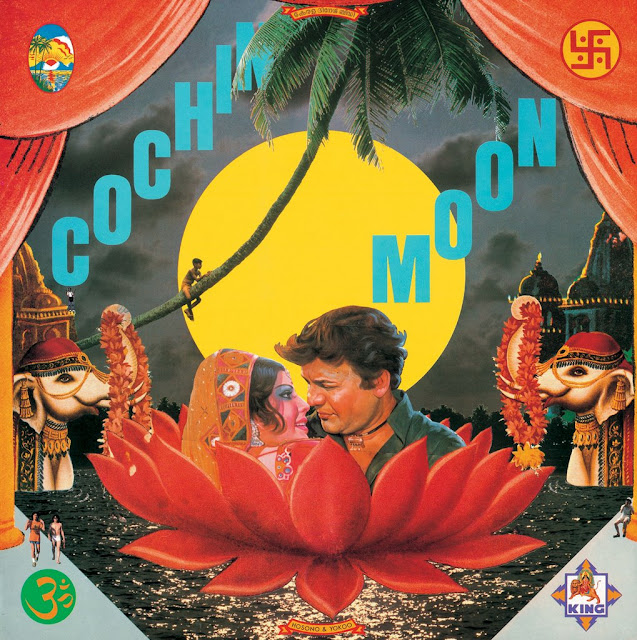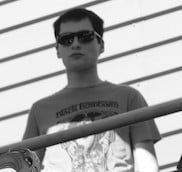/PAlogo_v2.gif) |
|
Post Reply 
|
| Author | |
hellogoodbye 
Forum Senior Member 

VIP member Joined: August 29 2011 Location: Troy Status: Offline Points: 7251 |
 Topic: 4 little gems (183) Topic: 4 little gems (183)Posted: February 19 2017 at 10:41 |
|
Egberto Gismonti : Academia de danças
https://www.youtube.com/watch?v=27Nl02ajTkM Haruoni Hosono : Cochin Moon https://www.youtube.com/watch?v=iM_9aalKOQk Craig Leon : Nommos https://www.youtube.com/watch?v=WTTaImeMubo Tom Nehls : I always catch the third second of a yellow light https://www.youtube.com/watch?v=An2c9GH-eZI
|
|
 |
|
hellogoodbye 
Forum Senior Member 

VIP member Joined: August 29 2011 Location: Troy Status: Offline Points: 7251 |
 Posted: February 19 2017 at 10:42 Posted: February 19 2017 at 10:42 |
 Tom Nehls - I Always Catch the Third Second of a Yellow Light (1973)Publié par Pilou72 sur 21 Mars 2008, 23:51pm Catégories : #Album of the Week Album labyrinthique et déboussolant, "I Always Catch The Third Second Of A Yellow Light" se présente comme une énigme indéchiffrable, défiant les lois de l'imagination : la musique amalgame librement musique d'ambiance (ou d'ascenseur), pop, psychédélique, progressive, jazz et électronique. Dédicacée aux Beatles, à Frank Zappa, et à J.R.R. Tolkien, la galette originale bénéficia à sa sortie d'un seul support radiophonique (WCCO, radio du Minnesota). L'engouement du public ne dépassa pas le cercle amical et comble de malheur, le stock d'invendus, entreposé dans la cave de la sœur de Tom Nehls, fut partiellement détruit par une inondation. |
|
 |
|
Lewian 
Prog Reviewer 

Joined: August 09 2015 Location: Italy Status: Offline Points: 14110 |
 Posted: February 19 2017 at 15:04 Posted: February 19 2017 at 15:04 |
|
I wanted to check out Gismonti for some time, thanks for making me do it eventually. What a stunning album! Wins my vote easily.
Leon sounded annoying in the beginning but after getting into the mood I actually realised there's something in this formal rigidity. Depending on my mood I could like this quite a bit. Nehls sounds like the kind of album I'd need far more time to get into. H. Hosono has its moments but overall it doesn't reach the others. |
|
 |
|
hellogoodbye 
Forum Senior Member 

VIP member Joined: August 29 2011 Location: Troy Status: Offline Points: 7251 |
 Posted: February 19 2017 at 15:11 Posted: February 19 2017 at 15:11 |
 Gismonti has so many great albums : Agua & Vinho, Em Familia, Sanfona ... etc. The Tom Nehls album is fantastic, but 1800 euros on Discogs. Gismonti has so many great albums : Agua & Vinho, Em Familia, Sanfona ... etc. The Tom Nehls album is fantastic, but 1800 euros on Discogs. 
|
|
 |
|
zravkapt 
Special Collaborator 

Honorary Collaborator Joined: October 12 2010 Location: Canada Status: Offline Points: 6446 |
 Posted: February 19 2017 at 18:22 Posted: February 19 2017 at 18:22 |
|
I know of Gismonti but I'm not sure if I've heard any of his music. I liked that album. Also liked the Craig Leon. The only one I've heard before and the one I voted was the Hosono.
|
|
|
Magma America Great Make Again
|
|
 |
|
Manuel 
Forum Senior Member 

Joined: March 09 2007 Location: United States Status: Offline Points: 12382 |
 Posted: February 19 2017 at 19:16 Posted: February 19 2017 at 19:16 |
|
Craig Leon for me.
|
|
 |
|
hellogoodbye 
Forum Senior Member 

VIP member Joined: August 29 2011 Location: Troy Status: Offline Points: 7251 |
 Posted: February 20 2017 at 01:16 Posted: February 20 2017 at 01:16 |
|
Tanks guys !

|
|
 |
|
hellogoodbye 
Forum Senior Member 

VIP member Joined: August 29 2011 Location: Troy Status: Offline Points: 7251 |
 Posted: February 20 2017 at 01:20 Posted: February 20 2017 at 01:20 |
 Before performing with Ryuichi Sakamoto in classic Japanese synth pop outfit Yellow Magic Orchestra (or just YMO), producer and onetime session bassist Haruomi Hosono made his share of eclectic music. If you're familiar with YMO, you might imagine he was involved in Kraftwerk-influenced electronic music, or perhaps more traditional pop, but as it happens, he made his name as session bassist and playing in bands like the psychedelic Apryl Fool and folk rockers Happy End-- a far cry from the modernist slant of his reputation in the West. However, he also made a record in 1978 called Cochin Moon with keyboardist Shuka Nishihara, and future YMO bandmates Sakamoto and Hideki Matsutake that is arguably more bizarre and forward thinking than anything he's done since. Cochin Moon-- co-credited to Pop artist Tadanori Yokoo, who did the incredible Bollywood-style cover art-- is an electro-tropical soundtrack to a fake movie of the same name. That is, there was no film called Cochin Moon, but after visiting India, Hosono was inspired to make music suggesting the exotic, luxurious, and seemingly wonder-filled scenarios played out in Indian cinemas. However, the actual sound he and his cohorts came up with is often a world away from India: Imagine a totally electronic world of chattering bugs, fluttering birds, magic harps and drums that alternate between a thud and a blip. Hosono shares compositional duties with Nishihara, and Sakamoto's playing style is readily on display, as are Matsutake's considerable programming skills. As a historical document to YMO fans, Cochin Moon is interesting; as a slice of out-music stuck somewhere between Tangerine Dream, Wendy Carlos and Disney's Fantasia, it's almost classic. Hosono's "Malabar Hotel" trilogy-- comprised of a "Ground Floor", "Upper Floor" and "Roof Garden"-- occupied the first side of the original LP, and eases me in like a snake. The brief "Ground Floor...Triangle Circuit on the Sea-Forest" begins with high-pitched insect-sirens, soft enough to mistake for crickets even when I know analog synths and primitive computers generate them. In the distance are waves breaking on a shore, and soon bass synth notes and alarms go off signaling the transition into the "Upper Floor...Moving Triangle". As a THX-esque sound test introduces fluttering percolations, an off-balanced, Indian-styled beat materializes. Half the beat is on the right, and half on the left; in between, where a snare should be, sits only the call of some robotic frog and a fly that just won't go away. This is tropical, and I can hear a pattern creep up from behind, and what sounds like men chanting. Filtered through an alien vocoder, it's difficult to decipher what they're saying, and as soon as I get close enough to make out the fuzzy, sonic outline of their words, they're interrupted by stuttering bass melody that eventually turns into a demi-cadenza, held afloat by ever more quickly percolating drum machine pulses. Bursts of angelic chord clusters accentuate the ends of melodic phrases, and from out of nowhere come electronic harp glissandi. Up and down, forward and backwards it runs, and soon the fizz of synthetic ocean mist drowns out the pulse, leaving only enough room for the pixie-bell harp, sudden eruptions of lava bubbles and that damn fly. "Roof Garden...Revel Attack" is born out of the fly's orbit, and introduces squeaky (near glitch) underwater computer blips. They start soft and spaced out, but soon gather momentum, all the while turning the fly buzz into a chorus of warped jet trail. A human voice speaking Japanese dips above the cacophony, and someone appears to be unwrapping a small package on the right. Then, just as suddenly, a synth line reminiscent of the melody from the "Upper Floor" reappears, with digitally harmonized voices supplying watercolor fanfares. The harp returns, in counterpoint with helicopter pulse on the right. The helicopter, apparently not satisfied in its supporting role, grows larger, overwhelming the competing melodies with sprawling whirl, and soon with more watery mist, like a rainstorm called on by a village shaman. And after a while, the storm passes, marked by the toll of a gong. And the fly is still there, buzzing in its lowest register before the gong closes the doors of the hotel and the piece fades into black. Nishihara's pieces are a bit less exotic, but no less interesting. "Hepatitis" is a shiny, bouncy piece of computer pop that might work well as a soundtrack to a Pixar sci-fi short about robotic fish. The bubbling sound effects are everywhere to be found, while cartoon-y melodies and state-of-1978 synth programming turn what might otherwise overwhelm itself with its own goofiness into something more bizarre. "Hum Ghar Sajan" (apparently, taken from a phrase by Indian guru Granth Sahib) is understated synth raga, as if informed equally by Kraftwerk and Ravi Shankar-- and accurately predicts Asa Chang & Junray's excursions into electro-exotica. A chanted vocal melody gives the song a mystical edge, and its recurring, high-pitched instrumental solo breaks sound straight out of Indian classical music. "Madam Consul General of Madras" is more tribal, sounding like ritualistic gamelan music meeting head on with the electronic tone poems of Wendy Carlos. Gradually, layers are painted on top, including a spazzed out synth line and more percolated synth patter sounding leftover from the Malabar's lobby, and the piece dissolves into dizzying keyboard clutter and the cricket sirens from the "Ground Floor". And I guess you can check out any time you like, but...well, you know the rest. |
|
 |
|
Meltdowner 
Special Collaborator 

Honorary Collaborator Joined: June 25 2013 Location: Portugal Status: Offline Points: 10215 |
 Posted: February 20 2017 at 09:04 Posted: February 20 2017 at 09:04 |
|
My preference order is how you listed them. All great choices though.
|
|
 |
|
The Dark Elf 
Forum Senior Member 

VIP Member Joined: February 01 2011 Location: Michigan Status: Offline Points: 12695 |
 Posted: February 20 2017 at 09:16 Posted: February 20 2017 at 09:16 |
|
Gismonti.
|
|
|
...a vigorous circular motion hitherto unknown to the people of this area, but destined
to take the place of the mud shark in your mythology... |
|
 |
|
hellogoodbye 
Forum Senior Member 

VIP member Joined: August 29 2011 Location: Troy Status: Offline Points: 7251 |
 Posted: February 20 2017 at 09:34 Posted: February 20 2017 at 09:34 |
|
Saravah !
 |
|
 |
|
hellogoodbye 
Forum Senior Member 

VIP member Joined: August 29 2011 Location: Troy Status: Offline Points: 7251 |
 Posted: February 21 2017 at 01:08 Posted: February 21 2017 at 01:08 |
 His first film soundtrack was A Penultima Donzela (1969), followed by many others on an almost yearly basis. He was also composing music for ballet: Maracatu(1974), Coracoes Futuristas (1976),Conforme A Altura Do Sol (1978),Construcao (1978), etc. The highlights of his jazz period are: Danca Das Cabezas (november 1976), with percussionist "Nana" Vasconcelos, Sol Do Meio Dia (november 1977), with Vasconcelos, saxophonist Jan Garbarek, percussionist Collin Walcott and guitarist Ralph Towner,Gismonti/Vasconcelos/Smetak (1979), Solo(november 1978), Magico (june 1979) and Folksongs (november 1979), with bassist Charlie Haden and saxophonist Jan Garbarek, the double-album Sanfona (november 1980), which returned to his Brazilian roots, Duas Vozes (june 1984), with Nana Vasconcelos. Other albums of the early 1980s include:Circense (1980), Em Famiglia (june 1981),Fantasia (1982), Sonhos De Castro Alves(1982), Cidade Cora‡ao (1983), Violao(february 1983), Egberto Gismondi & Hermeto Paschoal (1983). His later albums are more relaxed and personal: Egberto Gismonti (1984), Trem Caipira (september 1985), Alma (october 1986), Feixe De Luz (1988), Pagador De Promessas (1988), Kuarup (1989), the cryptic solo Danca Dos Escravos (november 1988), the group effort Infancia (november 1990), Amazonia (1991), El Viaje (1992),Casa Das Andorinhas (1992), Musica De Sobrevivencia (april 1993), Meeting Point (june 1995) with the Lithuanian State Symphony Orchestra. His film soundtracks became more ambitious with La Bela Palomera (1987), Kuarup(1988), Amazonia (1990), El Viaje (1991). His neoclassical works include several compositions for chamber orchestra, such asDanca das Sombras (1983), Strawa no Sertao(1991) and Realejo (1991), ten String Quartets (1987-90), Cabinda (1992), Imagem & Variacoes (1992). Other ballets include:Natura (1988), Inconfidentes (1988),Iemanja (1990), Dancas Solitarias (1990), etc. |
|
 |
|
hellogoodbye 
Forum Senior Member 

VIP member Joined: August 29 2011 Location: Troy Status: Offline Points: 7251 |
 Posted: February 21 2017 at 13:44 Posted: February 21 2017 at 13:44 |
 The name Craig Leon won’t be familiar to most music fans, but take away the albums he recorded and our Top Albums of the 1970s list would look very different indeed. In the late 70s, Leon produced crucial albums that defined the punk and new wave landscape for future generations, ranging from the recorded debuts of Suicide and Blondie to the Ramones’ self-titled and Richard Hell & the Voidoids’ Blank Generation EP (as well as the early singles from DMZ, Weirdoes and Zeros records released on Greg Shaw’s mighty Bomp! imprint). It’s easy to imagine that Leon brought a certain level of professionalism to these earliest punk sessions-- these days, Leon mostly produces classical recordings for the likes of Luciano Pavarotti, the London Symphony Orchestra and Joshua Bell-- but for his own debut album, Nommos, one can hear how the punks rubbed off on him. Originally released on John Fahey’s Takoma imprint in 1981, Leon’s debut album joined ranks alongside such glorious catalog oddities as The Psychedelic Saxophone of Charlie Nothing, Joesph Byrd’s Yankee Transcendoodle and Basho Sings!, not to mention Fahey himself, prone to play guitar atop audio collages of Tibetan monks and Nazi marches. And since Takoma is also regarded as the birthplace of placid New Age guitar, releasing early albums from George Winston and Will Ackerman, one can only imagine how Nommos made a certain type of music listener’s teeth grind, to where the album stands alone as the most audacious and “punk” effort ever released on that label. So it makes sense that it's remained out of print for 30 years. Since then, it’s found favor with Fall fans (Leon produced three early 90s Fall albums), fans of industrial and primitive electronic music, techno enthusiasts as well as the recent spate of noise artists like Pete Swanson and Andy Stott who pair bracing noise to 4/4 pummel, to where the album fetches ludicrous sums online. Booted in the past few years, it now sees a more legitimate release. Opener “Ring With Three Concentric Discs” sets the album’s tone in a slightly schizophrenic manner. There’s a nerve-rattling metallic loop not unlike a broken fan belt thwacking aluminum siding but before long, a gorgeous warbling synth melody drifts over the noise, just smoothing down the sharp edges so that it might find good company alongside Cluster & Eno or Harald Grosskopf. It then leads into the polyrhythmic tock of “Donkeys Bearing Cups", which sounds like every hi-hat, handclap, snare, rattle and thump was triggered by one of Kraftwerk’s showroom dummies: stiff yet strangely funky. About a minute in, Leon introduces some unidentifiable noise that does its best anticipation of My Bloody Valentine, at once blinding and body-melting. The title track again strikes a balance between skeletal beat and juxtaposed synth line that with its sense of strange negative space seems to be a subconscious template for the sorts of beats the Neptunes would craft two decades later for Hell Hath No Fury. The eleven-minute “Four Eyes To See The Afterlife” and seven-minute robotic rhumba of closer “She Wears A Hemispherical Skull Cap” comprise Nommos’s second half. And it’s here that the sparseness of Leon’s evocative metallic throbs slowly but surely steer the album away from merely being strange electronic music to drop into an adventurous DJ set into a more rarefied and unsettling space. “Afterlife” slowly develops from a near-empty clang to something approaching hypnosis. And when a female wail arises midway through the piece, it turns into this anxious slice of early 80s electronic minimalism that has few peers. It’s a strain of minimal, nearly New Age music that-- rather than dissolve your anxieties away-- gives you the night creeps. |
|
 |
|
Post Reply 
|
|
| Forum Jump | Forum Permissions  You cannot post new topics in this forum You cannot reply to topics in this forum You cannot delete your posts in this forum You cannot edit your posts in this forum You cannot create polls in this forum You cannot vote in polls in this forum |